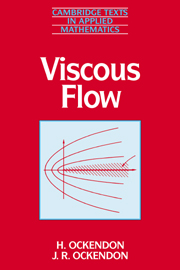5 - Spatial and temporal complexity
Published online by Cambridge University Press: 05 June 2012
Summary
All the solutions considered so far have had very regular streamlines or particle paths but a glance at the weather or a smoke plume shows that spatial and temporal complexity arises in many common situations. In this chapter we will look at some situations where, in spite of this complexity, a mathematical model can be made of at least some aspects of the physical problem. We begin with the problem of flow in a porous medium where the spatial complexity can be averaged to give a smoothly varying macroscopic model.
Flow in a porous medium
Surprisingly, the Hele-Shaw model of Chapter 4 can be used as a model for the geometrically complicated problem of flow of a viscous fluid through a porous medium. Such a model is relevant in many practical situations such as oil recovery, hydrology, soil mechanics, filter design, and fluidized beds as well as numerous other phenomena in the earth sciences. The most basic model assumes that, besides there being an obvious microscopic flow scale defined by the ‘pore’ size and illustrated in figure 5.1, there is a much larger macroscopic scale over which the problem is to be studied; this macroscopic scale may be the overall dimensions of the industrial device or the oil field. We can make progress by working on an intermediate scale which is small compared to the macroscopic scale yet still contains enough pores for an averaged velocity u and pressure p to be defined.
- Type
- Chapter
- Information
- Viscous Flow , pp. 83 - 100Publisher: Cambridge University PressPrint publication year: 1995



